Financial Ratios and Corporate Governance
VerifiedAdded on 2021/09/14
|19
|3449
|52
AI Summary
Contribute Materials
Your contribution can guide someone’s learning journey. Share your
documents today.

Running head: FINANCE
FINANCE
Name of the Student
Name of the University
Author Note
FINANCE
Name of the Student
Name of the University
Author Note
Secure Best Marks with AI Grader
Need help grading? Try our AI Grader for instant feedback on your assignments.
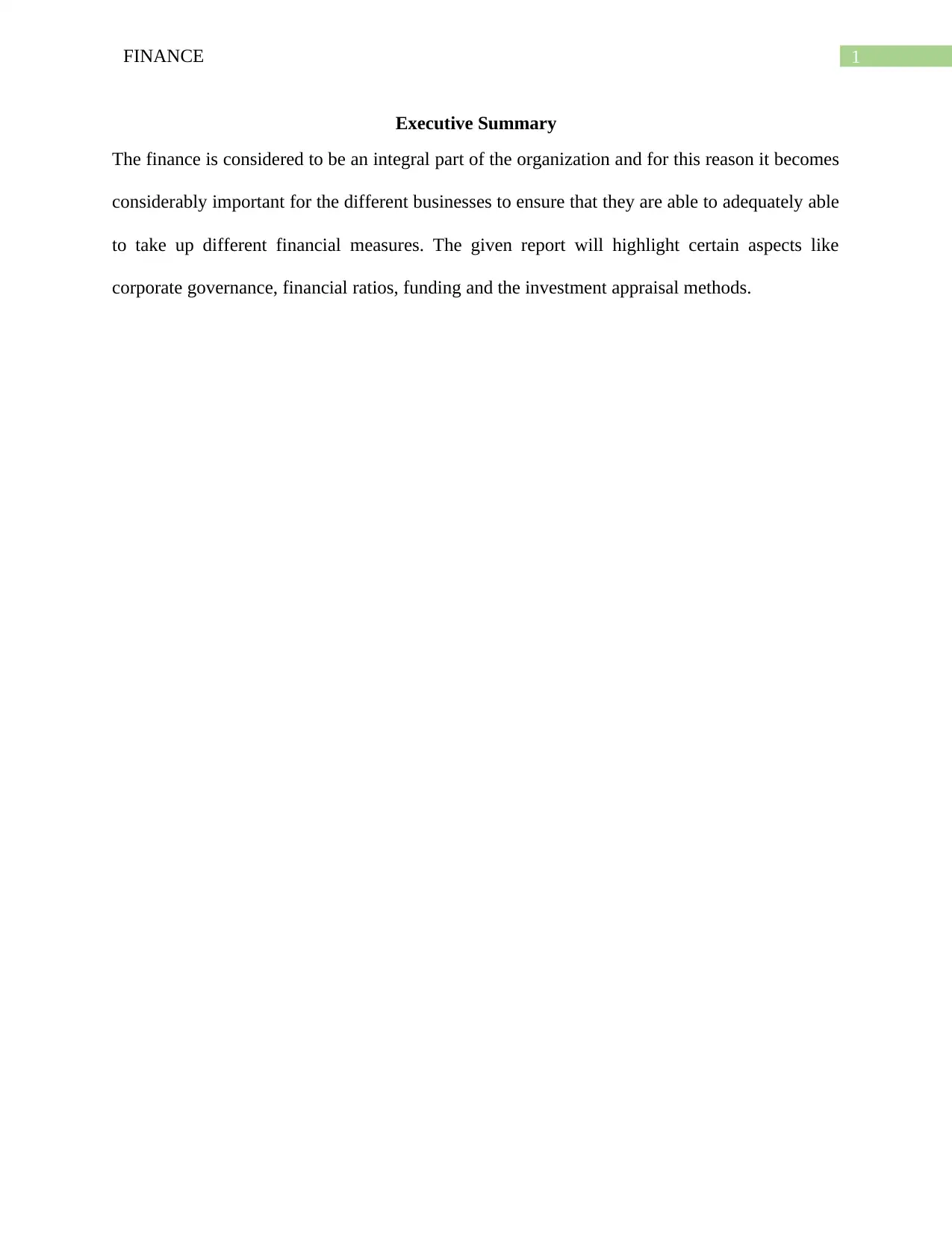
1FINANCE
Executive Summary
The finance is considered to be an integral part of the organization and for this reason it becomes
considerably important for the different businesses to ensure that they are able to adequately able
to take up different financial measures. The given report will highlight certain aspects like
corporate governance, financial ratios, funding and the investment appraisal methods.
Executive Summary
The finance is considered to be an integral part of the organization and for this reason it becomes
considerably important for the different businesses to ensure that they are able to adequately able
to take up different financial measures. The given report will highlight certain aspects like
corporate governance, financial ratios, funding and the investment appraisal methods.

2FINANCE
Table of Contents
Question 1........................................................................................................................................3
Part a............................................................................................................................................3
Part b............................................................................................................................................4
Question 2........................................................................................................................................5
Question 3......................................................................................................................................10
Part a..........................................................................................................................................10
Part b..........................................................................................................................................12
Question 4......................................................................................................................................12
Part a..........................................................................................................................................12
Payback period...........................................................................................................................13
Discounted Payback Period.......................................................................................................14
Accounting Rate of Return........................................................................................................14
Net present Value......................................................................................................................15
Part b..........................................................................................................................................15
References and Bibliography.........................................................................................................17
Table of Contents
Question 1........................................................................................................................................3
Part a............................................................................................................................................3
Part b............................................................................................................................................4
Question 2........................................................................................................................................5
Question 3......................................................................................................................................10
Part a..........................................................................................................................................10
Part b..........................................................................................................................................12
Question 4......................................................................................................................................12
Part a..........................................................................................................................................12
Payback period...........................................................................................................................13
Discounted Payback Period.......................................................................................................14
Accounting Rate of Return........................................................................................................14
Net present Value......................................................................................................................15
Part b..........................................................................................................................................15
References and Bibliography.........................................................................................................17
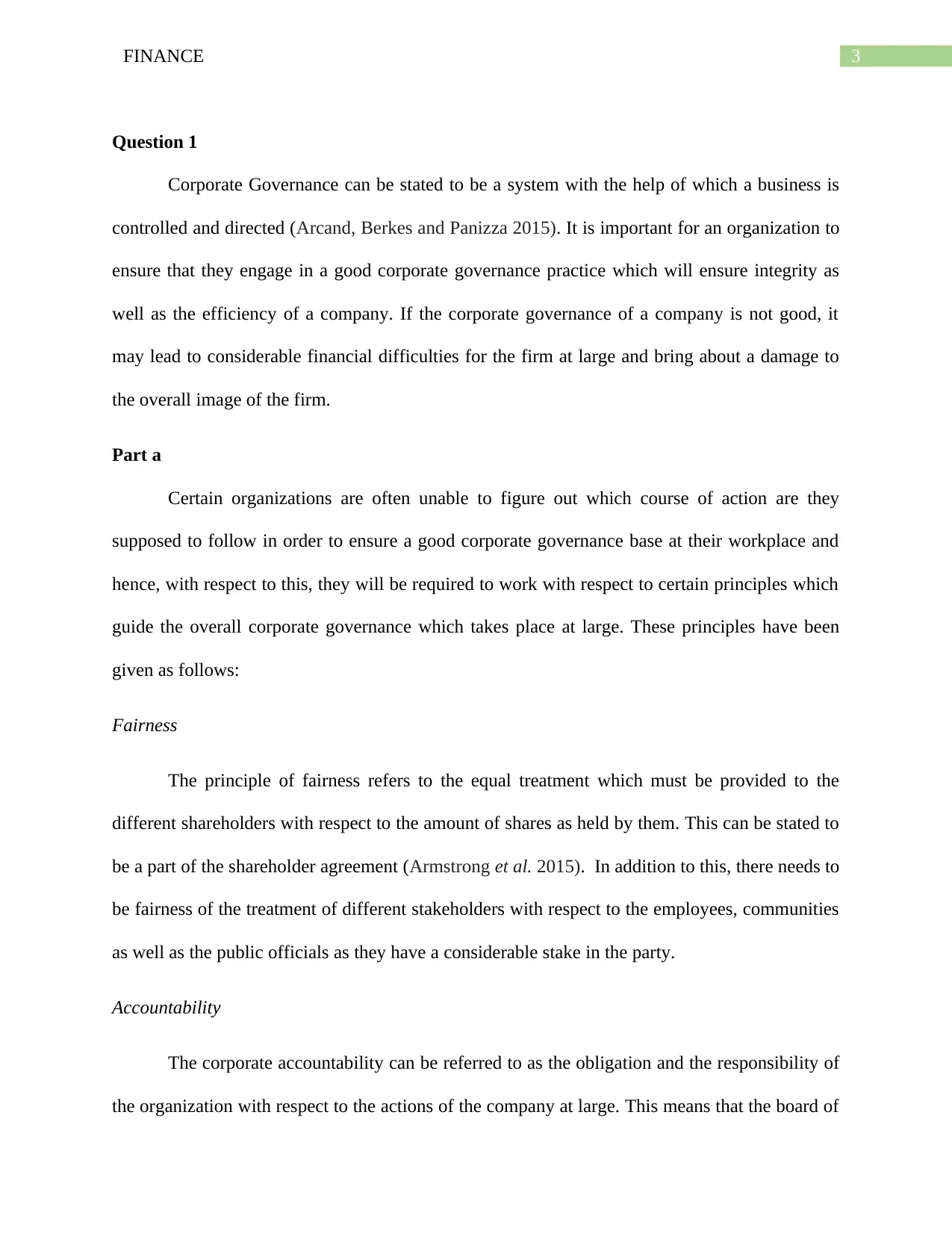
3FINANCE
Question 1
Corporate Governance can be stated to be a system with the help of which a business is
controlled and directed (Arcand, Berkes and Panizza 2015). It is important for an organization to
ensure that they engage in a good corporate governance practice which will ensure integrity as
well as the efficiency of a company. If the corporate governance of a company is not good, it
may lead to considerable financial difficulties for the firm at large and bring about a damage to
the overall image of the firm.
Part a
Certain organizations are often unable to figure out which course of action are they
supposed to follow in order to ensure a good corporate governance base at their workplace and
hence, with respect to this, they will be required to work with respect to certain principles which
guide the overall corporate governance which takes place at large. These principles have been
given as follows:
Fairness
The principle of fairness refers to the equal treatment which must be provided to the
different shareholders with respect to the amount of shares as held by them. This can be stated to
be a part of the shareholder agreement (Armstrong et al. 2015). In addition to this, there needs to
be fairness of the treatment of different stakeholders with respect to the employees, communities
as well as the public officials as they have a considerable stake in the party.
Accountability
The corporate accountability can be referred to as the obligation and the responsibility of
the organization with respect to the actions of the company at large. This means that the board of
Question 1
Corporate Governance can be stated to be a system with the help of which a business is
controlled and directed (Arcand, Berkes and Panizza 2015). It is important for an organization to
ensure that they engage in a good corporate governance practice which will ensure integrity as
well as the efficiency of a company. If the corporate governance of a company is not good, it
may lead to considerable financial difficulties for the firm at large and bring about a damage to
the overall image of the firm.
Part a
Certain organizations are often unable to figure out which course of action are they
supposed to follow in order to ensure a good corporate governance base at their workplace and
hence, with respect to this, they will be required to work with respect to certain principles which
guide the overall corporate governance which takes place at large. These principles have been
given as follows:
Fairness
The principle of fairness refers to the equal treatment which must be provided to the
different shareholders with respect to the amount of shares as held by them. This can be stated to
be a part of the shareholder agreement (Armstrong et al. 2015). In addition to this, there needs to
be fairness of the treatment of different stakeholders with respect to the employees, communities
as well as the public officials as they have a considerable stake in the party.
Accountability
The corporate accountability can be referred to as the obligation and the responsibility of
the organization with respect to the actions of the company at large. This means that the board of
Secure Best Marks with AI Grader
Need help grading? Try our AI Grader for instant feedback on your assignments.
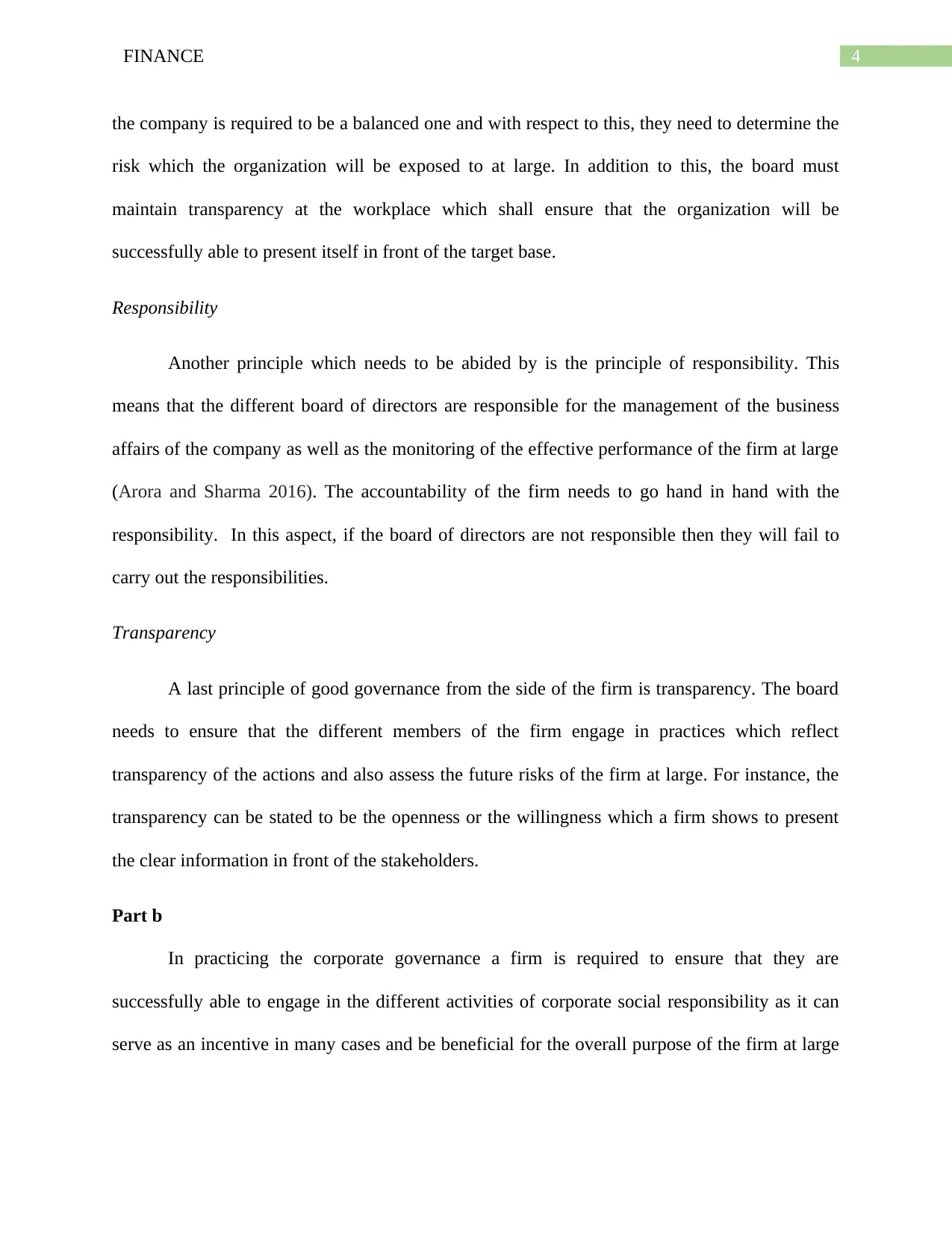
4FINANCE
the company is required to be a balanced one and with respect to this, they need to determine the
risk which the organization will be exposed to at large. In addition to this, the board must
maintain transparency at the workplace which shall ensure that the organization will be
successfully able to present itself in front of the target base.
Responsibility
Another principle which needs to be abided by is the principle of responsibility. This
means that the different board of directors are responsible for the management of the business
affairs of the company as well as the monitoring of the effective performance of the firm at large
(Arora and Sharma 2016). The accountability of the firm needs to go hand in hand with the
responsibility. In this aspect, if the board of directors are not responsible then they will fail to
carry out the responsibilities.
Transparency
A last principle of good governance from the side of the firm is transparency. The board
needs to ensure that the different members of the firm engage in practices which reflect
transparency of the actions and also assess the future risks of the firm at large. For instance, the
transparency can be stated to be the openness or the willingness which a firm shows to present
the clear information in front of the stakeholders.
Part b
In practicing the corporate governance a firm is required to ensure that they are
successfully able to engage in the different activities of corporate social responsibility as it can
serve as an incentive in many cases and be beneficial for the overall purpose of the firm at large
the company is required to be a balanced one and with respect to this, they need to determine the
risk which the organization will be exposed to at large. In addition to this, the board must
maintain transparency at the workplace which shall ensure that the organization will be
successfully able to present itself in front of the target base.
Responsibility
Another principle which needs to be abided by is the principle of responsibility. This
means that the different board of directors are responsible for the management of the business
affairs of the company as well as the monitoring of the effective performance of the firm at large
(Arora and Sharma 2016). The accountability of the firm needs to go hand in hand with the
responsibility. In this aspect, if the board of directors are not responsible then they will fail to
carry out the responsibilities.
Transparency
A last principle of good governance from the side of the firm is transparency. The board
needs to ensure that the different members of the firm engage in practices which reflect
transparency of the actions and also assess the future risks of the firm at large. For instance, the
transparency can be stated to be the openness or the willingness which a firm shows to present
the clear information in front of the stakeholders.
Part b
In practicing the corporate governance a firm is required to ensure that they are
successfully able to engage in the different activities of corporate social responsibility as it can
serve as an incentive in many cases and be beneficial for the overall purpose of the firm at large
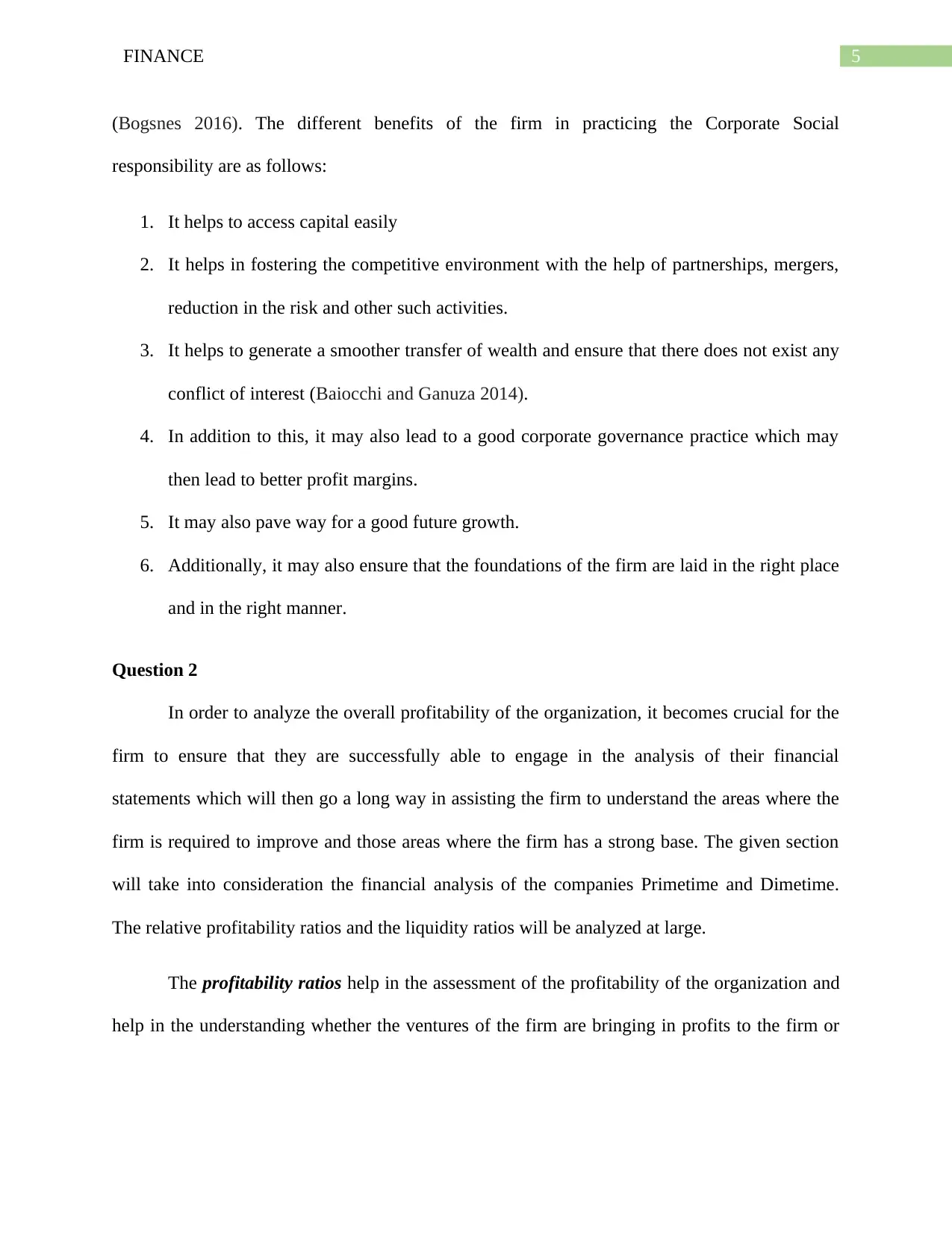
5FINANCE
(Bogsnes 2016). The different benefits of the firm in practicing the Corporate Social
responsibility are as follows:
1. It helps to access capital easily
2. It helps in fostering the competitive environment with the help of partnerships, mergers,
reduction in the risk and other such activities.
3. It helps to generate a smoother transfer of wealth and ensure that there does not exist any
conflict of interest (Baiocchi and Ganuza 2014).
4. In addition to this, it may also lead to a good corporate governance practice which may
then lead to better profit margins.
5. It may also pave way for a good future growth.
6. Additionally, it may also ensure that the foundations of the firm are laid in the right place
and in the right manner.
Question 2
In order to analyze the overall profitability of the organization, it becomes crucial for the
firm to ensure that they are successfully able to engage in the analysis of their financial
statements which will then go a long way in assisting the firm to understand the areas where the
firm is required to improve and those areas where the firm has a strong base. The given section
will take into consideration the financial analysis of the companies Primetime and Dimetime.
The relative profitability ratios and the liquidity ratios will be analyzed at large.
The profitability ratios help in the assessment of the profitability of the organization and
help in the understanding whether the ventures of the firm are bringing in profits to the firm or
(Bogsnes 2016). The different benefits of the firm in practicing the Corporate Social
responsibility are as follows:
1. It helps to access capital easily
2. It helps in fostering the competitive environment with the help of partnerships, mergers,
reduction in the risk and other such activities.
3. It helps to generate a smoother transfer of wealth and ensure that there does not exist any
conflict of interest (Baiocchi and Ganuza 2014).
4. In addition to this, it may also lead to a good corporate governance practice which may
then lead to better profit margins.
5. It may also pave way for a good future growth.
6. Additionally, it may also ensure that the foundations of the firm are laid in the right place
and in the right manner.
Question 2
In order to analyze the overall profitability of the organization, it becomes crucial for the
firm to ensure that they are successfully able to engage in the analysis of their financial
statements which will then go a long way in assisting the firm to understand the areas where the
firm is required to improve and those areas where the firm has a strong base. The given section
will take into consideration the financial analysis of the companies Primetime and Dimetime.
The relative profitability ratios and the liquidity ratios will be analyzed at large.
The profitability ratios help in the assessment of the profitability of the organization and
help in the understanding whether the ventures of the firm are bringing in profits to the firm or
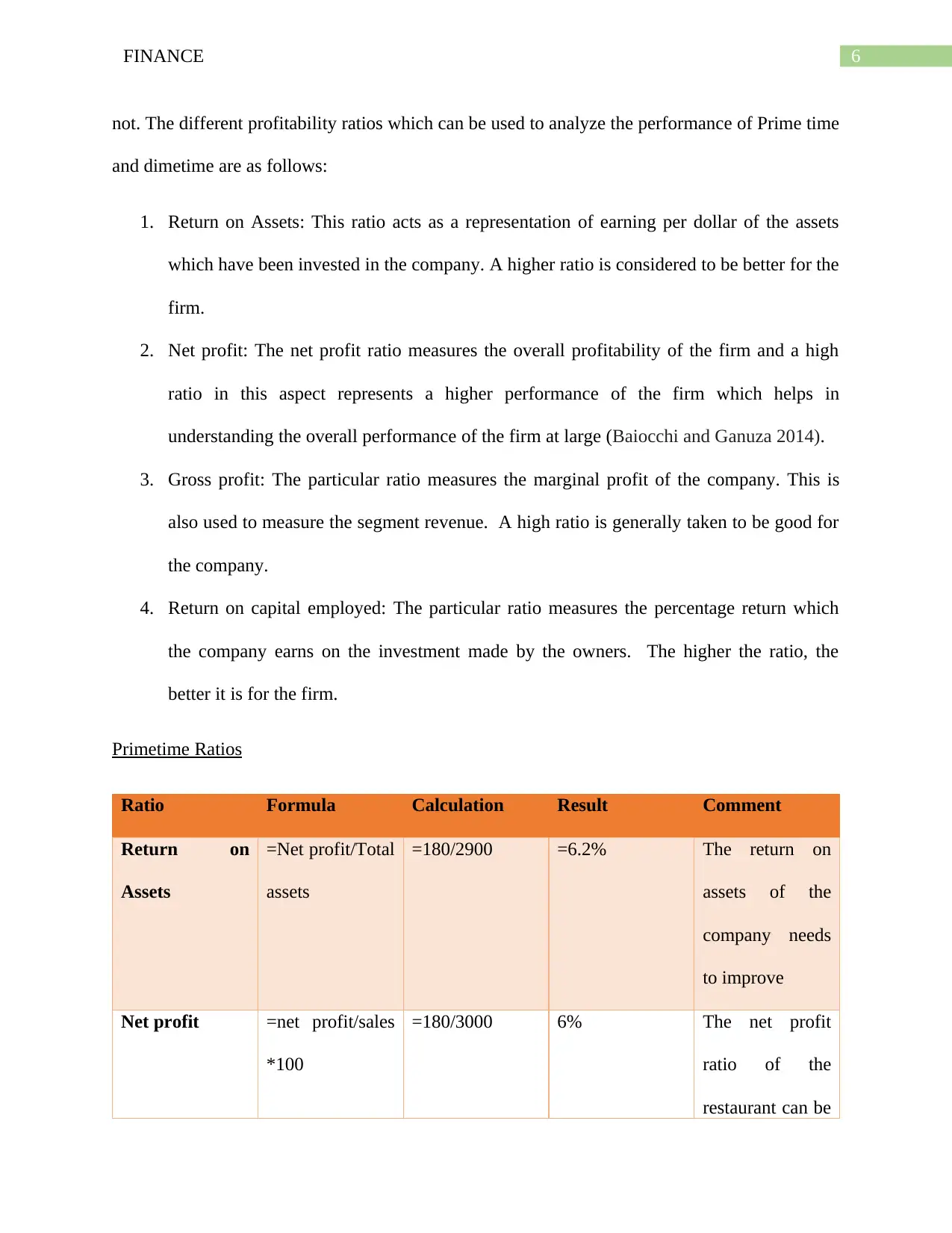
6FINANCE
not. The different profitability ratios which can be used to analyze the performance of Prime time
and dimetime are as follows:
1. Return on Assets: This ratio acts as a representation of earning per dollar of the assets
which have been invested in the company. A higher ratio is considered to be better for the
firm.
2. Net profit: The net profit ratio measures the overall profitability of the firm and a high
ratio in this aspect represents a higher performance of the firm which helps in
understanding the overall performance of the firm at large (Baiocchi and Ganuza 2014).
3. Gross profit: The particular ratio measures the marginal profit of the company. This is
also used to measure the segment revenue. A high ratio is generally taken to be good for
the company.
4. Return on capital employed: The particular ratio measures the percentage return which
the company earns on the investment made by the owners. The higher the ratio, the
better it is for the firm.
Primetime Ratios
Ratio Formula Calculation Result Comment
Return on
Assets
=Net profit/Total
assets
=180/2900 =6.2% The return on
assets of the
company needs
to improve
Net profit =net profit/sales
*100
=180/3000 6% The net profit
ratio of the
restaurant can be
not. The different profitability ratios which can be used to analyze the performance of Prime time
and dimetime are as follows:
1. Return on Assets: This ratio acts as a representation of earning per dollar of the assets
which have been invested in the company. A higher ratio is considered to be better for the
firm.
2. Net profit: The net profit ratio measures the overall profitability of the firm and a high
ratio in this aspect represents a higher performance of the firm which helps in
understanding the overall performance of the firm at large (Baiocchi and Ganuza 2014).
3. Gross profit: The particular ratio measures the marginal profit of the company. This is
also used to measure the segment revenue. A high ratio is generally taken to be good for
the company.
4. Return on capital employed: The particular ratio measures the percentage return which
the company earns on the investment made by the owners. The higher the ratio, the
better it is for the firm.
Primetime Ratios
Ratio Formula Calculation Result Comment
Return on
Assets
=Net profit/Total
assets
=180/2900 =6.2% The return on
assets of the
company needs
to improve
Net profit =net profit/sales
*100
=180/3000 6% The net profit
ratio of the
restaurant can be
Paraphrase This Document
Need a fresh take? Get an instant paraphrase of this document with our AI Paraphraser
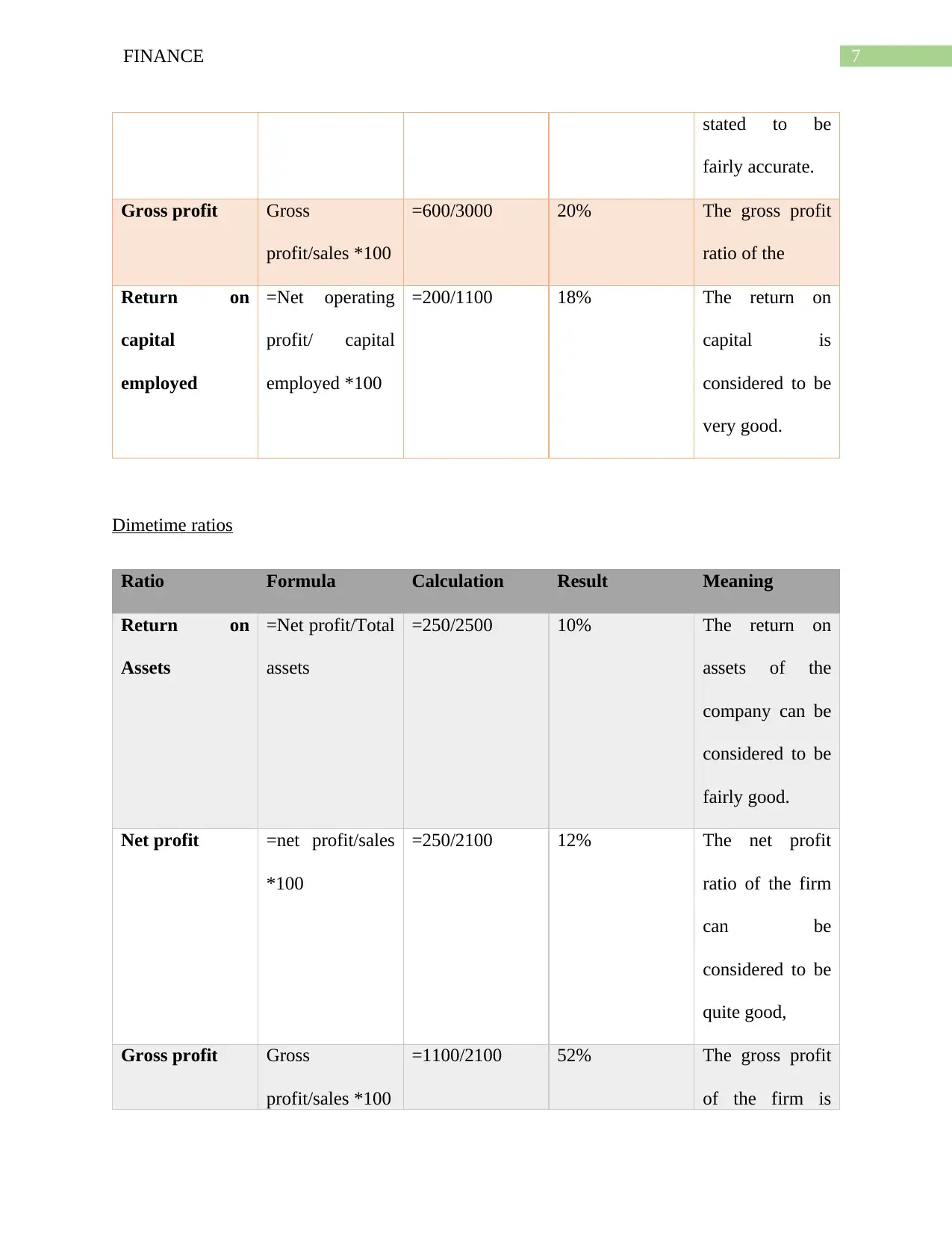
7FINANCE
stated to be
fairly accurate.
Gross profit Gross
profit/sales *100
=600/3000 20% The gross profit
ratio of the
Return on
capital
employed
=Net operating
profit/ capital
employed *100
=200/1100 18% The return on
capital is
considered to be
very good.
Dimetime ratios
Ratio Formula Calculation Result Meaning
Return on
Assets
=Net profit/Total
assets
=250/2500 10% The return on
assets of the
company can be
considered to be
fairly good.
Net profit =net profit/sales
*100
=250/2100 12% The net profit
ratio of the firm
can be
considered to be
quite good,
Gross profit Gross
profit/sales *100
=1100/2100 52% The gross profit
of the firm is
stated to be
fairly accurate.
Gross profit Gross
profit/sales *100
=600/3000 20% The gross profit
ratio of the
Return on
capital
employed
=Net operating
profit/ capital
employed *100
=200/1100 18% The return on
capital is
considered to be
very good.
Dimetime ratios
Ratio Formula Calculation Result Meaning
Return on
Assets
=Net profit/Total
assets
=250/2500 10% The return on
assets of the
company can be
considered to be
fairly good.
Net profit =net profit/sales
*100
=250/2100 12% The net profit
ratio of the firm
can be
considered to be
quite good,
Gross profit Gross
profit/sales *100
=1100/2100 52% The gross profit
of the firm is
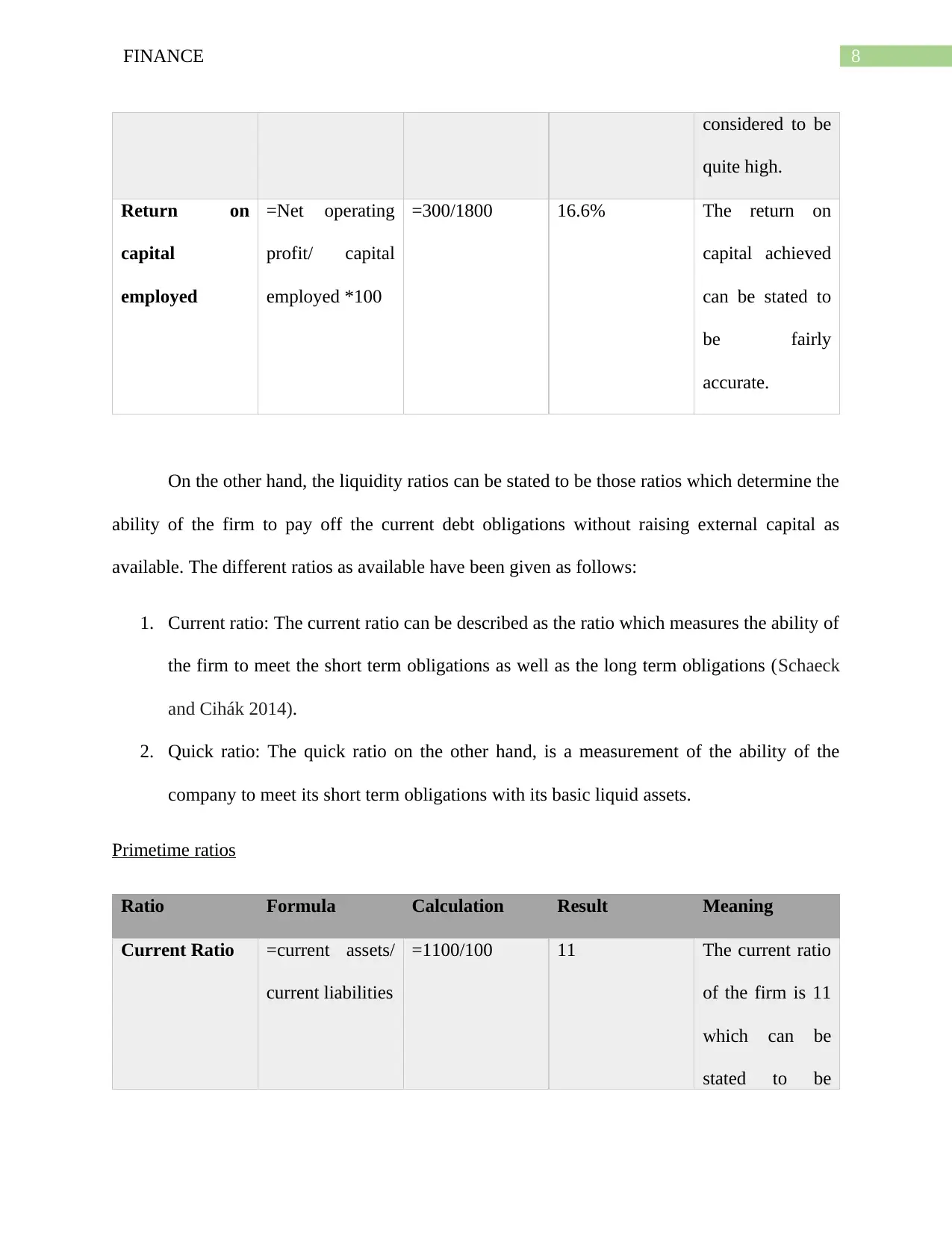
8FINANCE
considered to be
quite high.
Return on
capital
employed
=Net operating
profit/ capital
employed *100
=300/1800 16.6% The return on
capital achieved
can be stated to
be fairly
accurate.
On the other hand, the liquidity ratios can be stated to be those ratios which determine the
ability of the firm to pay off the current debt obligations without raising external capital as
available. The different ratios as available have been given as follows:
1. Current ratio: The current ratio can be described as the ratio which measures the ability of
the firm to meet the short term obligations as well as the long term obligations (Schaeck
and Cihák 2014).
2. Quick ratio: The quick ratio on the other hand, is a measurement of the ability of the
company to meet its short term obligations with its basic liquid assets.
Primetime ratios
Ratio Formula Calculation Result Meaning
Current Ratio =current assets/
current liabilities
=1100/100 11 The current ratio
of the firm is 11
which can be
stated to be
considered to be
quite high.
Return on
capital
employed
=Net operating
profit/ capital
employed *100
=300/1800 16.6% The return on
capital achieved
can be stated to
be fairly
accurate.
On the other hand, the liquidity ratios can be stated to be those ratios which determine the
ability of the firm to pay off the current debt obligations without raising external capital as
available. The different ratios as available have been given as follows:
1. Current ratio: The current ratio can be described as the ratio which measures the ability of
the firm to meet the short term obligations as well as the long term obligations (Schaeck
and Cihák 2014).
2. Quick ratio: The quick ratio on the other hand, is a measurement of the ability of the
company to meet its short term obligations with its basic liquid assets.
Primetime ratios
Ratio Formula Calculation Result Meaning
Current Ratio =current assets/
current liabilities
=1100/100 11 The current ratio
of the firm is 11
which can be
stated to be
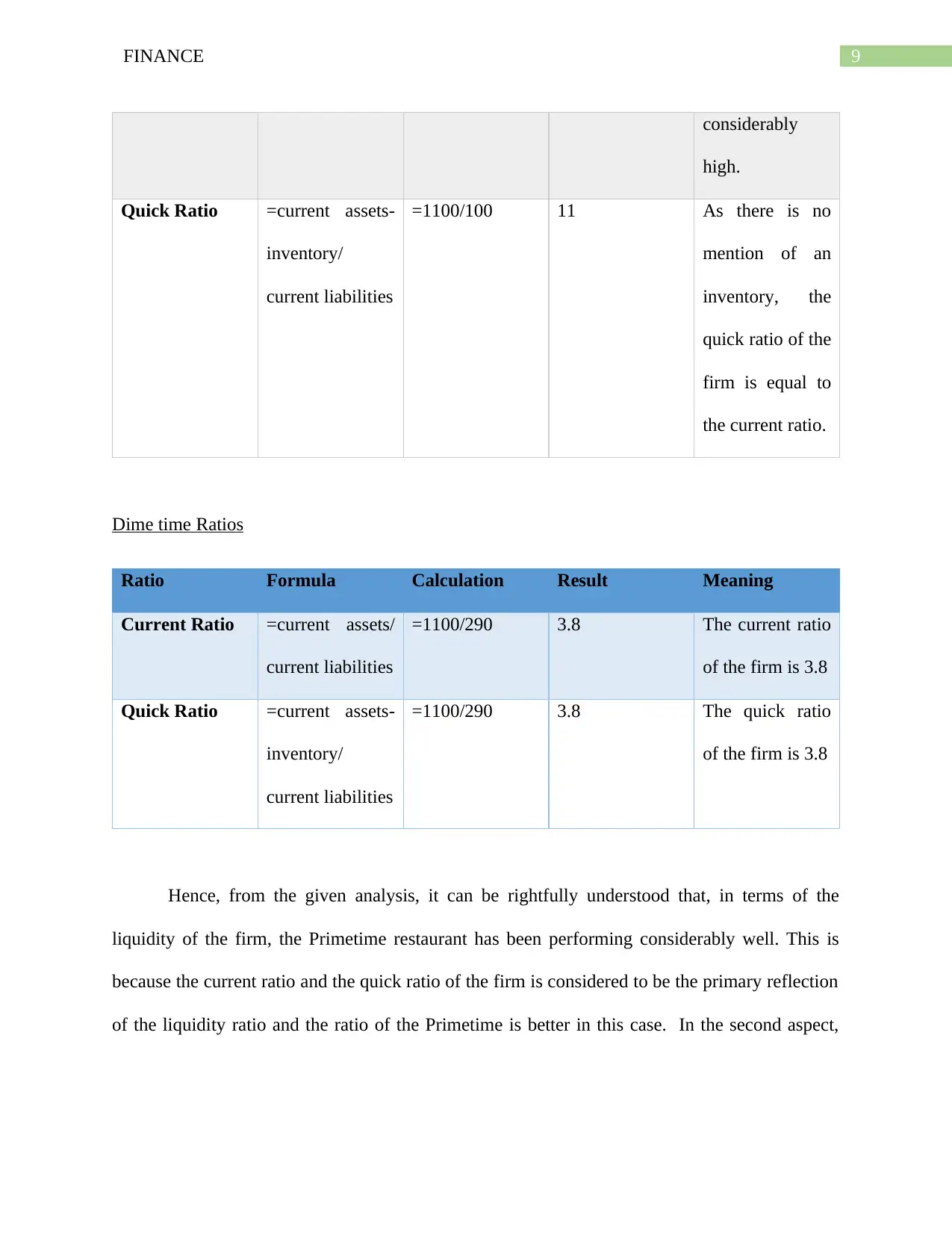
9FINANCE
considerably
high.
Quick Ratio =current assets-
inventory/
current liabilities
=1100/100 11 As there is no
mention of an
inventory, the
quick ratio of the
firm is equal to
the current ratio.
Dime time Ratios
Ratio Formula Calculation Result Meaning
Current Ratio =current assets/
current liabilities
=1100/290 3.8 The current ratio
of the firm is 3.8
Quick Ratio =current assets-
inventory/
current liabilities
=1100/290 3.8 The quick ratio
of the firm is 3.8
Hence, from the given analysis, it can be rightfully understood that, in terms of the
liquidity of the firm, the Primetime restaurant has been performing considerably well. This is
because the current ratio and the quick ratio of the firm is considered to be the primary reflection
of the liquidity ratio and the ratio of the Primetime is better in this case. In the second aspect,
considerably
high.
Quick Ratio =current assets-
inventory/
current liabilities
=1100/100 11 As there is no
mention of an
inventory, the
quick ratio of the
firm is equal to
the current ratio.
Dime time Ratios
Ratio Formula Calculation Result Meaning
Current Ratio =current assets/
current liabilities
=1100/290 3.8 The current ratio
of the firm is 3.8
Quick Ratio =current assets-
inventory/
current liabilities
=1100/290 3.8 The quick ratio
of the firm is 3.8
Hence, from the given analysis, it can be rightfully understood that, in terms of the
liquidity of the firm, the Primetime restaurant has been performing considerably well. This is
because the current ratio and the quick ratio of the firm is considered to be the primary reflection
of the liquidity ratio and the ratio of the Primetime is better in this case. In the second aspect,
Secure Best Marks with AI Grader
Need help grading? Try our AI Grader for instant feedback on your assignments.
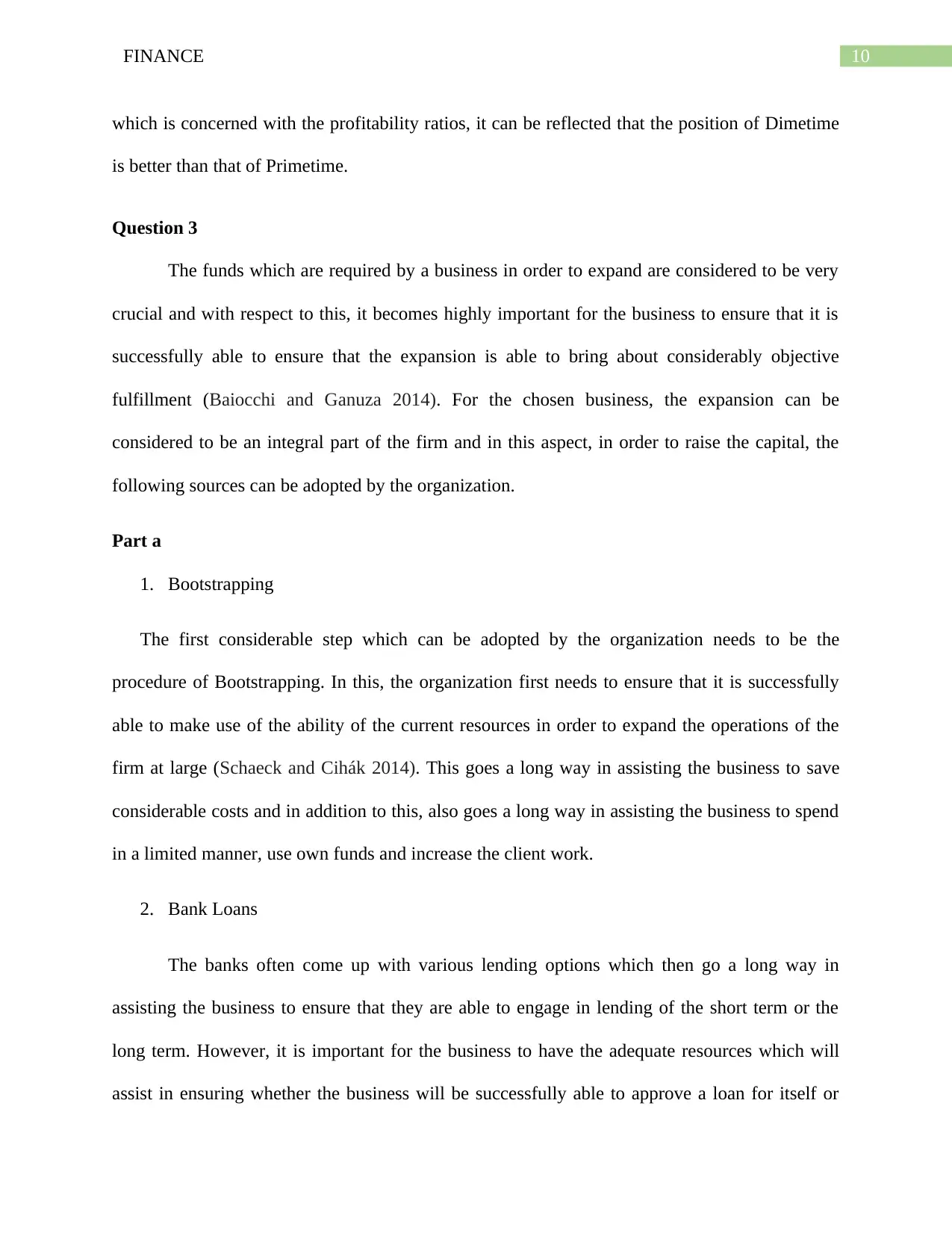
10FINANCE
which is concerned with the profitability ratios, it can be reflected that the position of Dimetime
is better than that of Primetime.
Question 3
The funds which are required by a business in order to expand are considered to be very
crucial and with respect to this, it becomes highly important for the business to ensure that it is
successfully able to ensure that the expansion is able to bring about considerably objective
fulfillment (Baiocchi and Ganuza 2014). For the chosen business, the expansion can be
considered to be an integral part of the firm and in this aspect, in order to raise the capital, the
following sources can be adopted by the organization.
Part a
1. Bootstrapping
The first considerable step which can be adopted by the organization needs to be the
procedure of Bootstrapping. In this, the organization first needs to ensure that it is successfully
able to make use of the ability of the current resources in order to expand the operations of the
firm at large (Schaeck and Cihák 2014). This goes a long way in assisting the business to save
considerable costs and in addition to this, also goes a long way in assisting the business to spend
in a limited manner, use own funds and increase the client work.
2. Bank Loans
The banks often come up with various lending options which then go a long way in
assisting the business to ensure that they are able to engage in lending of the short term or the
long term. However, it is important for the business to have the adequate resources which will
assist in ensuring whether the business will be successfully able to approve a loan for itself or
which is concerned with the profitability ratios, it can be reflected that the position of Dimetime
is better than that of Primetime.
Question 3
The funds which are required by a business in order to expand are considered to be very
crucial and with respect to this, it becomes highly important for the business to ensure that it is
successfully able to ensure that the expansion is able to bring about considerably objective
fulfillment (Baiocchi and Ganuza 2014). For the chosen business, the expansion can be
considered to be an integral part of the firm and in this aspect, in order to raise the capital, the
following sources can be adopted by the organization.
Part a
1. Bootstrapping
The first considerable step which can be adopted by the organization needs to be the
procedure of Bootstrapping. In this, the organization first needs to ensure that it is successfully
able to make use of the ability of the current resources in order to expand the operations of the
firm at large (Schaeck and Cihák 2014). This goes a long way in assisting the business to save
considerable costs and in addition to this, also goes a long way in assisting the business to spend
in a limited manner, use own funds and increase the client work.
2. Bank Loans
The banks often come up with various lending options which then go a long way in
assisting the business to ensure that they are able to engage in lending of the short term or the
long term. However, it is important for the business to have the adequate resources which will
assist in ensuring whether the business will be successfully able to approve a loan for itself or
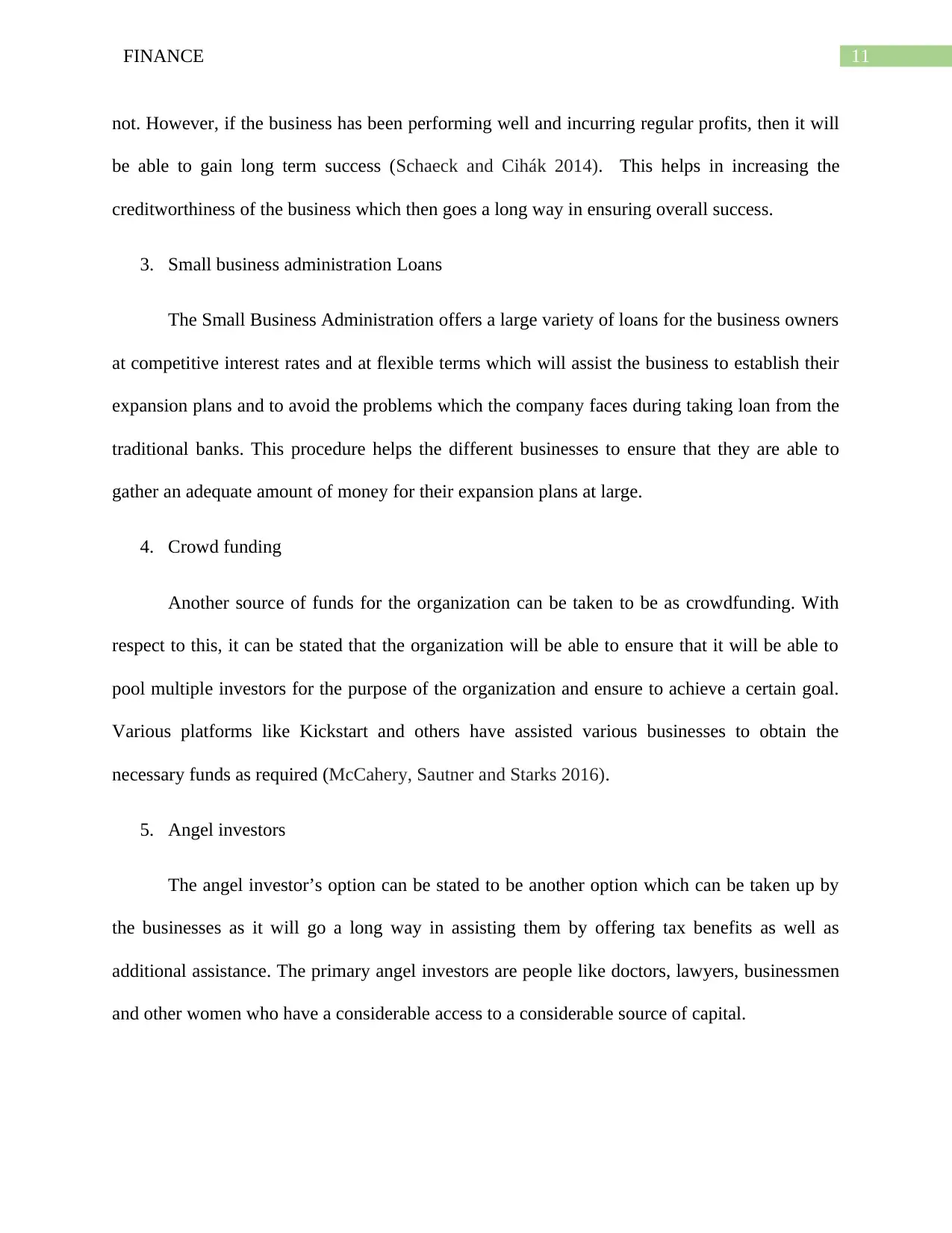
11FINANCE
not. However, if the business has been performing well and incurring regular profits, then it will
be able to gain long term success (Schaeck and Cihák 2014). This helps in increasing the
creditworthiness of the business which then goes a long way in ensuring overall success.
3. Small business administration Loans
The Small Business Administration offers a large variety of loans for the business owners
at competitive interest rates and at flexible terms which will assist the business to establish their
expansion plans and to avoid the problems which the company faces during taking loan from the
traditional banks. This procedure helps the different businesses to ensure that they are able to
gather an adequate amount of money for their expansion plans at large.
4. Crowd funding
Another source of funds for the organization can be taken to be as crowdfunding. With
respect to this, it can be stated that the organization will be able to ensure that it will be able to
pool multiple investors for the purpose of the organization and ensure to achieve a certain goal.
Various platforms like Kickstart and others have assisted various businesses to obtain the
necessary funds as required (McCahery, Sautner and Starks 2016).
5. Angel investors
The angel investor’s option can be stated to be another option which can be taken up by
the businesses as it will go a long way in assisting them by offering tax benefits as well as
additional assistance. The primary angel investors are people like doctors, lawyers, businessmen
and other women who have a considerable access to a considerable source of capital.
not. However, if the business has been performing well and incurring regular profits, then it will
be able to gain long term success (Schaeck and Cihák 2014). This helps in increasing the
creditworthiness of the business which then goes a long way in ensuring overall success.
3. Small business administration Loans
The Small Business Administration offers a large variety of loans for the business owners
at competitive interest rates and at flexible terms which will assist the business to establish their
expansion plans and to avoid the problems which the company faces during taking loan from the
traditional banks. This procedure helps the different businesses to ensure that they are able to
gather an adequate amount of money for their expansion plans at large.
4. Crowd funding
Another source of funds for the organization can be taken to be as crowdfunding. With
respect to this, it can be stated that the organization will be able to ensure that it will be able to
pool multiple investors for the purpose of the organization and ensure to achieve a certain goal.
Various platforms like Kickstart and others have assisted various businesses to obtain the
necessary funds as required (McCahery, Sautner and Starks 2016).
5. Angel investors
The angel investor’s option can be stated to be another option which can be taken up by
the businesses as it will go a long way in assisting them by offering tax benefits as well as
additional assistance. The primary angel investors are people like doctors, lawyers, businessmen
and other women who have a considerable access to a considerable source of capital.
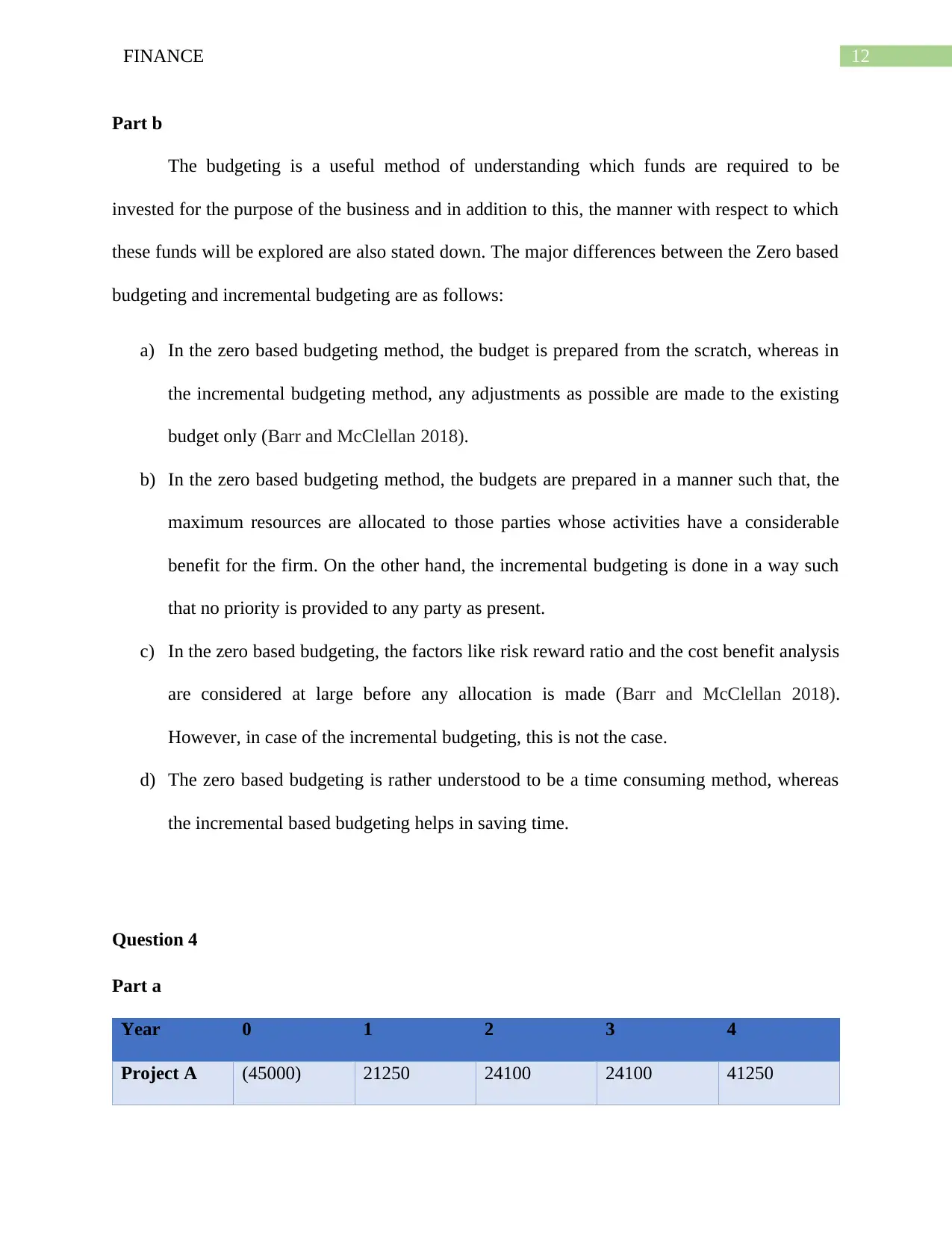
12FINANCE
Part b
The budgeting is a useful method of understanding which funds are required to be
invested for the purpose of the business and in addition to this, the manner with respect to which
these funds will be explored are also stated down. The major differences between the Zero based
budgeting and incremental budgeting are as follows:
a) In the zero based budgeting method, the budget is prepared from the scratch, whereas in
the incremental budgeting method, any adjustments as possible are made to the existing
budget only (Barr and McClellan 2018).
b) In the zero based budgeting method, the budgets are prepared in a manner such that, the
maximum resources are allocated to those parties whose activities have a considerable
benefit for the firm. On the other hand, the incremental budgeting is done in a way such
that no priority is provided to any party as present.
c) In the zero based budgeting, the factors like risk reward ratio and the cost benefit analysis
are considered at large before any allocation is made (Barr and McClellan 2018).
However, in case of the incremental budgeting, this is not the case.
d) The zero based budgeting is rather understood to be a time consuming method, whereas
the incremental based budgeting helps in saving time.
Question 4
Part a
Year 0 1 2 3 4
Project A (45000) 21250 24100 24100 41250
Part b
The budgeting is a useful method of understanding which funds are required to be
invested for the purpose of the business and in addition to this, the manner with respect to which
these funds will be explored are also stated down. The major differences between the Zero based
budgeting and incremental budgeting are as follows:
a) In the zero based budgeting method, the budget is prepared from the scratch, whereas in
the incremental budgeting method, any adjustments as possible are made to the existing
budget only (Barr and McClellan 2018).
b) In the zero based budgeting method, the budgets are prepared in a manner such that, the
maximum resources are allocated to those parties whose activities have a considerable
benefit for the firm. On the other hand, the incremental budgeting is done in a way such
that no priority is provided to any party as present.
c) In the zero based budgeting, the factors like risk reward ratio and the cost benefit analysis
are considered at large before any allocation is made (Barr and McClellan 2018).
However, in case of the incremental budgeting, this is not the case.
d) The zero based budgeting is rather understood to be a time consuming method, whereas
the incremental based budgeting helps in saving time.
Question 4
Part a
Year 0 1 2 3 4
Project A (45000) 21250 24100 24100 41250
Paraphrase This Document
Need a fresh take? Get an instant paraphrase of this document with our AI Paraphraser

13FINANCE
Project B (45000) 28750 29050 27250 27500
Payback period
Project A
=Cost of the project/ Annual cash flows
Year 0 1 2 3 4
Project A (45000) 21250 24100 24100 41250
Cumulative
cash flow
-45000 -23750 350 23750 17500
Hence payback= 1+23750.24100
=1.98 years
Approximately 2 years
Project B
Year 0 1 2 3 4
Project B (45000) 28750 29050 27250 27500
Cumulative
cash flow
-45000 -16250 12800 14450 13050
Hence payback=1+16250/29050
=1.55
Project B (45000) 28750 29050 27250 27500
Payback period
Project A
=Cost of the project/ Annual cash flows
Year 0 1 2 3 4
Project A (45000) 21250 24100 24100 41250
Cumulative
cash flow
-45000 -23750 350 23750 17500
Hence payback= 1+23750.24100
=1.98 years
Approximately 2 years
Project B
Year 0 1 2 3 4
Project B (45000) 28750 29050 27250 27500
Cumulative
cash flow
-45000 -16250 12800 14450 13050
Hence payback=1+16250/29050
=1.55

14FINANCE
Discounted Payback Period
Year 0 1 2 3 4
Project A (45000) 21250 24100 24100 41250
Discounted
Value
-45000 0.917*21250
=19486
0.842*24100
=20292
0.772*24100
=17419
0.708*41250
=29205
cumulative -25514 -5222 12917 42122
Project B (45000) 28750 29050 27250 27500
Discounted
Value
-45000 0.917*28750
=26363
0.842*29050
=24460
0.772*27250
=21037
0.708*27500
=19470
cumulative -18637 -5823 15214 34684
Project a
2 years +12917/17419
=2.74
Project B
2 years +15214/21037
=2.72
Accounting Rate of Return
=Average profit/ Average investment
Project A
=19486+20292+17419+29205/45000(AVERAGE)
=21600/11250
Discounted Payback Period
Year 0 1 2 3 4
Project A (45000) 21250 24100 24100 41250
Discounted
Value
-45000 0.917*21250
=19486
0.842*24100
=20292
0.772*24100
=17419
0.708*41250
=29205
cumulative -25514 -5222 12917 42122
Project B (45000) 28750 29050 27250 27500
Discounted
Value
-45000 0.917*28750
=26363
0.842*29050
=24460
0.772*27250
=21037
0.708*27500
=19470
cumulative -18637 -5823 15214 34684
Project a
2 years +12917/17419
=2.74
Project B
2 years +15214/21037
=2.72
Accounting Rate of Return
=Average profit/ Average investment
Project A
=19486+20292+17419+29205/45000(AVERAGE)
=21600/11250
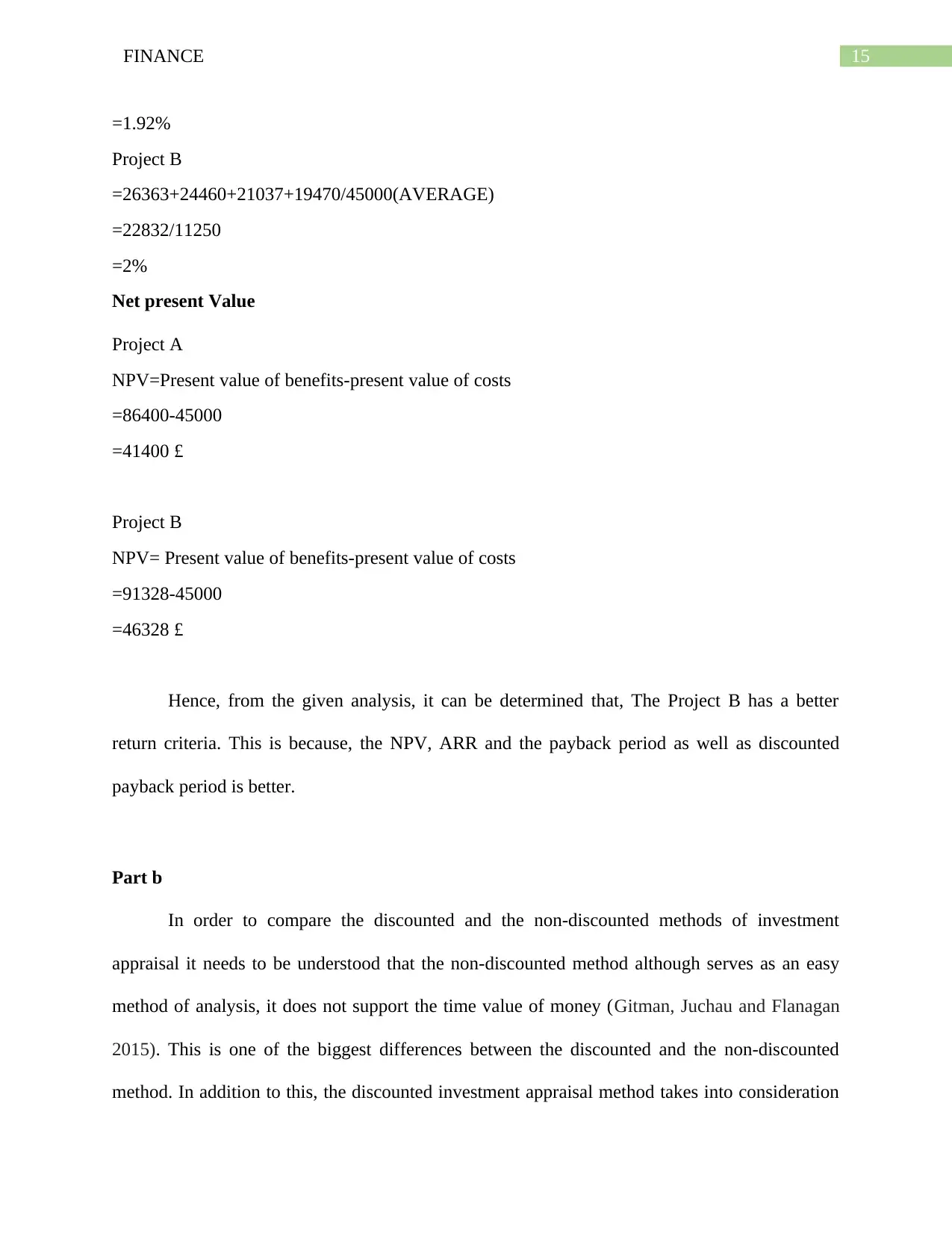
15FINANCE
=1.92%
Project B
=26363+24460+21037+19470/45000(AVERAGE)
=22832/11250
=2%
Net present Value
Project A
NPV=Present value of benefits-present value of costs
=86400-45000
=41400 £
Project B
NPV= Present value of benefits-present value of costs
=91328-45000
=46328 £
Hence, from the given analysis, it can be determined that, The Project B has a better
return criteria. This is because, the NPV, ARR and the payback period as well as discounted
payback period is better.
Part b
In order to compare the discounted and the non-discounted methods of investment
appraisal it needs to be understood that the non-discounted method although serves as an easy
method of analysis, it does not support the time value of money (Gitman, Juchau and Flanagan
2015). This is one of the biggest differences between the discounted and the non-discounted
method. In addition to this, the discounted investment appraisal method takes into consideration
=1.92%
Project B
=26363+24460+21037+19470/45000(AVERAGE)
=22832/11250
=2%
Net present Value
Project A
NPV=Present value of benefits-present value of costs
=86400-45000
=41400 £
Project B
NPV= Present value of benefits-present value of costs
=91328-45000
=46328 £
Hence, from the given analysis, it can be determined that, The Project B has a better
return criteria. This is because, the NPV, ARR and the payback period as well as discounted
payback period is better.
Part b
In order to compare the discounted and the non-discounted methods of investment
appraisal it needs to be understood that the non-discounted method although serves as an easy
method of analysis, it does not support the time value of money (Gitman, Juchau and Flanagan
2015). This is one of the biggest differences between the discounted and the non-discounted
method. In addition to this, the discounted investment appraisal method takes into consideration
Secure Best Marks with AI Grader
Need help grading? Try our AI Grader for instant feedback on your assignments.
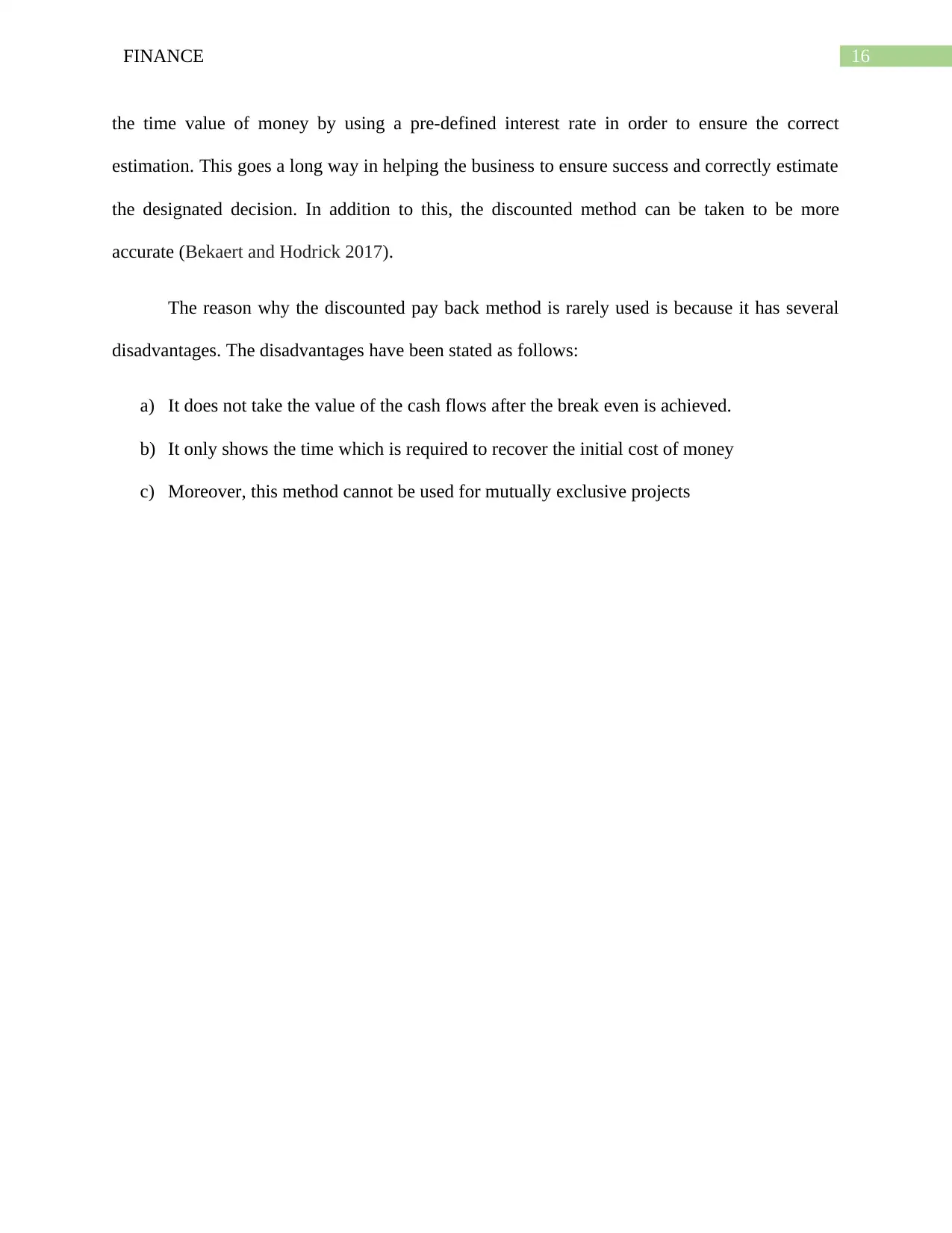
16FINANCE
the time value of money by using a pre-defined interest rate in order to ensure the correct
estimation. This goes a long way in helping the business to ensure success and correctly estimate
the designated decision. In addition to this, the discounted method can be taken to be more
accurate (Bekaert and Hodrick 2017).
The reason why the discounted pay back method is rarely used is because it has several
disadvantages. The disadvantages have been stated as follows:
a) It does not take the value of the cash flows after the break even is achieved.
b) It only shows the time which is required to recover the initial cost of money
c) Moreover, this method cannot be used for mutually exclusive projects
the time value of money by using a pre-defined interest rate in order to ensure the correct
estimation. This goes a long way in helping the business to ensure success and correctly estimate
the designated decision. In addition to this, the discounted method can be taken to be more
accurate (Bekaert and Hodrick 2017).
The reason why the discounted pay back method is rarely used is because it has several
disadvantages. The disadvantages have been stated as follows:
a) It does not take the value of the cash flows after the break even is achieved.
b) It only shows the time which is required to recover the initial cost of money
c) Moreover, this method cannot be used for mutually exclusive projects
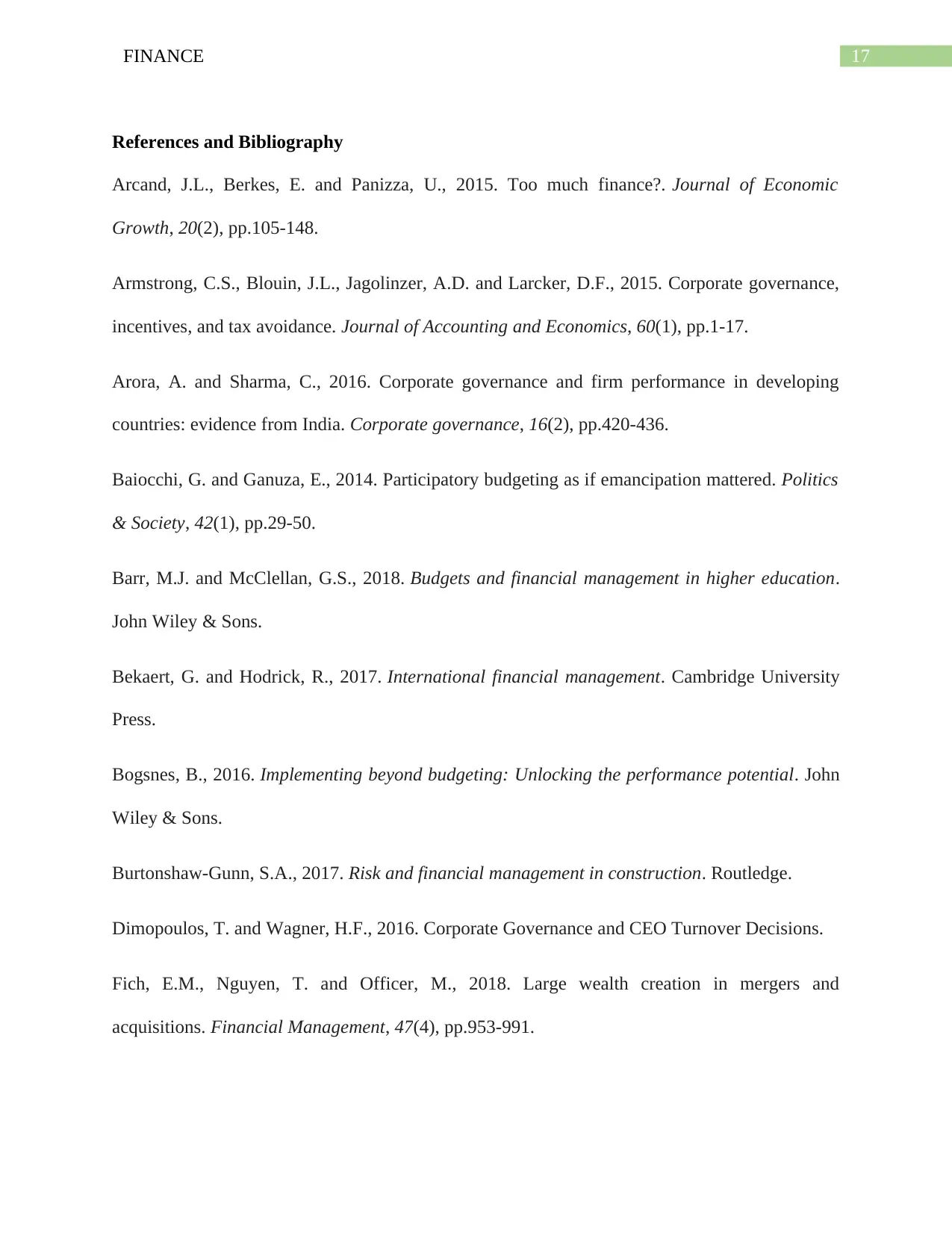
17FINANCE
References and Bibliography
Arcand, J.L., Berkes, E. and Panizza, U., 2015. Too much finance?. Journal of Economic
Growth, 20(2), pp.105-148.
Armstrong, C.S., Blouin, J.L., Jagolinzer, A.D. and Larcker, D.F., 2015. Corporate governance,
incentives, and tax avoidance. Journal of Accounting and Economics, 60(1), pp.1-17.
Arora, A. and Sharma, C., 2016. Corporate governance and firm performance in developing
countries: evidence from India. Corporate governance, 16(2), pp.420-436.
Baiocchi, G. and Ganuza, E., 2014. Participatory budgeting as if emancipation mattered. Politics
& Society, 42(1), pp.29-50.
Barr, M.J. and McClellan, G.S., 2018. Budgets and financial management in higher education.
John Wiley & Sons.
Bekaert, G. and Hodrick, R., 2017. International financial management. Cambridge University
Press.
Bogsnes, B., 2016. Implementing beyond budgeting: Unlocking the performance potential. John
Wiley & Sons.
Burtonshaw-Gunn, S.A., 2017. Risk and financial management in construction. Routledge.
Dimopoulos, T. and Wagner, H.F., 2016. Corporate Governance and CEO Turnover Decisions.
Fich, E.M., Nguyen, T. and Officer, M., 2018. Large wealth creation in mergers and
acquisitions. Financial Management, 47(4), pp.953-991.
References and Bibliography
Arcand, J.L., Berkes, E. and Panizza, U., 2015. Too much finance?. Journal of Economic
Growth, 20(2), pp.105-148.
Armstrong, C.S., Blouin, J.L., Jagolinzer, A.D. and Larcker, D.F., 2015. Corporate governance,
incentives, and tax avoidance. Journal of Accounting and Economics, 60(1), pp.1-17.
Arora, A. and Sharma, C., 2016. Corporate governance and firm performance in developing
countries: evidence from India. Corporate governance, 16(2), pp.420-436.
Baiocchi, G. and Ganuza, E., 2014. Participatory budgeting as if emancipation mattered. Politics
& Society, 42(1), pp.29-50.
Barr, M.J. and McClellan, G.S., 2018. Budgets and financial management in higher education.
John Wiley & Sons.
Bekaert, G. and Hodrick, R., 2017. International financial management. Cambridge University
Press.
Bogsnes, B., 2016. Implementing beyond budgeting: Unlocking the performance potential. John
Wiley & Sons.
Burtonshaw-Gunn, S.A., 2017. Risk and financial management in construction. Routledge.
Dimopoulos, T. and Wagner, H.F., 2016. Corporate Governance and CEO Turnover Decisions.
Fich, E.M., Nguyen, T. and Officer, M., 2018. Large wealth creation in mergers and
acquisitions. Financial Management, 47(4), pp.953-991.
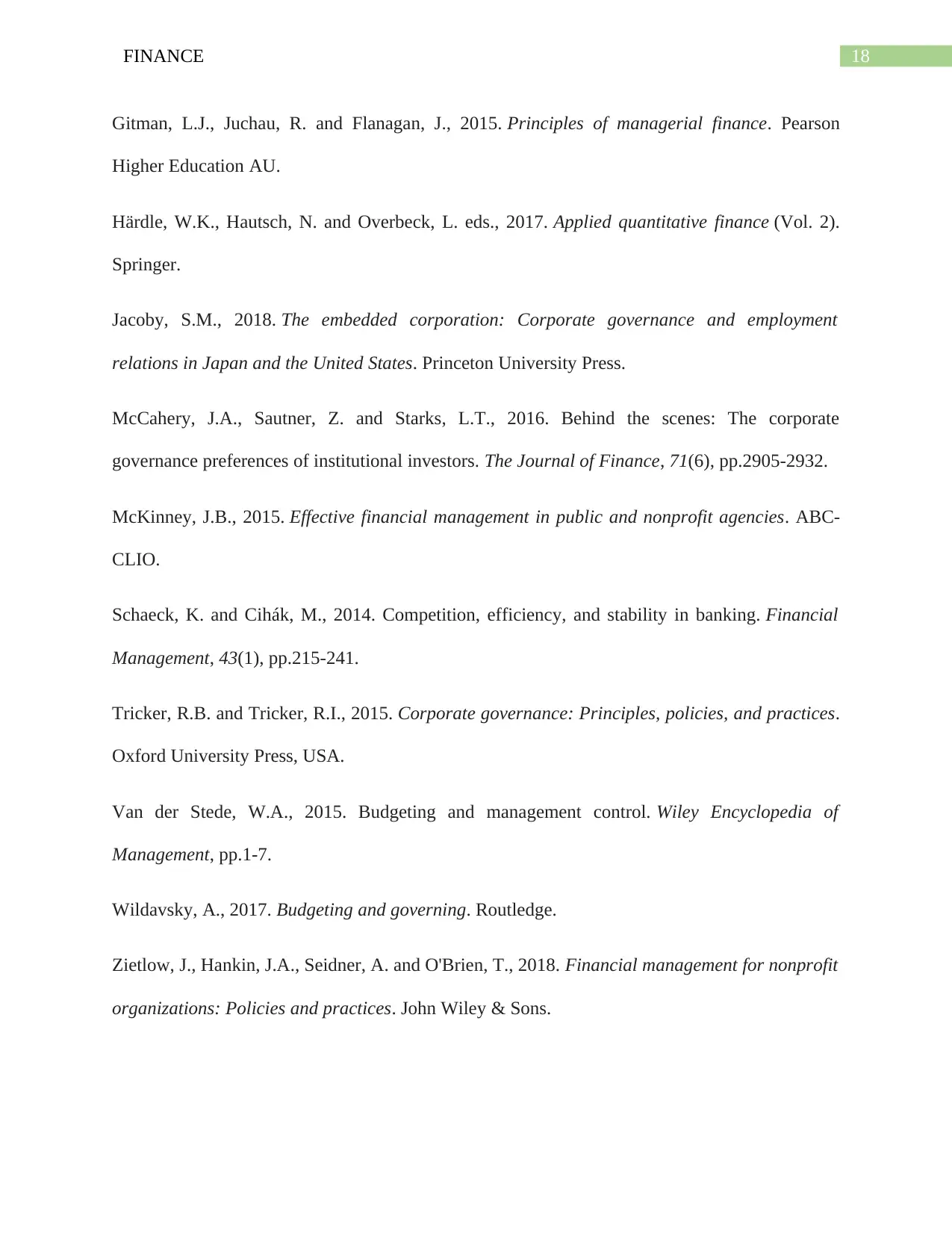
18FINANCE
Gitman, L.J., Juchau, R. and Flanagan, J., 2015. Principles of managerial finance. Pearson
Higher Education AU.
Härdle, W.K., Hautsch, N. and Overbeck, L. eds., 2017. Applied quantitative finance (Vol. 2).
Springer.
Jacoby, S.M., 2018. The embedded corporation: Corporate governance and employment
relations in Japan and the United States. Princeton University Press.
McCahery, J.A., Sautner, Z. and Starks, L.T., 2016. Behind the scenes: The corporate
governance preferences of institutional investors. The Journal of Finance, 71(6), pp.2905-2932.
McKinney, J.B., 2015. Effective financial management in public and nonprofit agencies. ABC-
CLIO.
Schaeck, K. and Cihák, M., 2014. Competition, efficiency, and stability in banking. Financial
Management, 43(1), pp.215-241.
Tricker, R.B. and Tricker, R.I., 2015. Corporate governance: Principles, policies, and practices.
Oxford University Press, USA.
Van der Stede, W.A., 2015. Budgeting and management control. Wiley Encyclopedia of
Management, pp.1-7.
Wildavsky, A., 2017. Budgeting and governing. Routledge.
Zietlow, J., Hankin, J.A., Seidner, A. and O'Brien, T., 2018. Financial management for nonprofit
organizations: Policies and practices. John Wiley & Sons.
Gitman, L.J., Juchau, R. and Flanagan, J., 2015. Principles of managerial finance. Pearson
Higher Education AU.
Härdle, W.K., Hautsch, N. and Overbeck, L. eds., 2017. Applied quantitative finance (Vol. 2).
Springer.
Jacoby, S.M., 2018. The embedded corporation: Corporate governance and employment
relations in Japan and the United States. Princeton University Press.
McCahery, J.A., Sautner, Z. and Starks, L.T., 2016. Behind the scenes: The corporate
governance preferences of institutional investors. The Journal of Finance, 71(6), pp.2905-2932.
McKinney, J.B., 2015. Effective financial management in public and nonprofit agencies. ABC-
CLIO.
Schaeck, K. and Cihák, M., 2014. Competition, efficiency, and stability in banking. Financial
Management, 43(1), pp.215-241.
Tricker, R.B. and Tricker, R.I., 2015. Corporate governance: Principles, policies, and practices.
Oxford University Press, USA.
Van der Stede, W.A., 2015. Budgeting and management control. Wiley Encyclopedia of
Management, pp.1-7.
Wildavsky, A., 2017. Budgeting and governing. Routledge.
Zietlow, J., Hankin, J.A., Seidner, A. and O'Brien, T., 2018. Financial management for nonprofit
organizations: Policies and practices. John Wiley & Sons.
1 out of 19
Related Documents
Your All-in-One AI-Powered Toolkit for Academic Success.
+13062052269
info@desklib.com
Available 24*7 on WhatsApp / Email
![[object Object]](/_next/static/media/star-bottom.7253800d.svg)
Unlock your academic potential
© 2024 | Zucol Services PVT LTD | All rights reserved.





